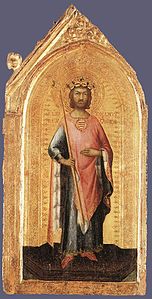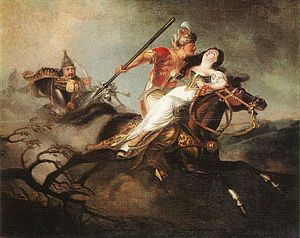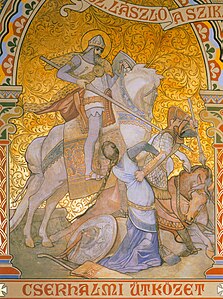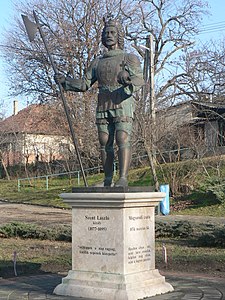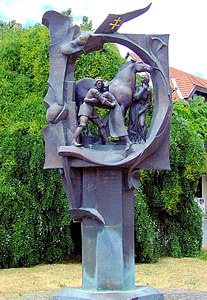Ladislaus I of Hungary
| Ladislaus I | |
|---|---|
Kingdom of Poland | |
| Died | 29 July 1095 (aged 54–55) Nyitra, Kingdom of Hungary (now Nitra, Slovakia) |
| Burial | Cathedral-Basilica of Nagyvárad (today Oradea, Romania) |
| Spouse | Adelaide of Rheinfelden |
| Issue more... | Empress Irene of Byzantium |
| Dynasty | Árpád dynasty |
| Father | Béla I of Hungary |
| Mother | Richeza or Adelaide of Poland |
Ladislaus I (
Géza died in 1077, and his supporters made Ladislaus king. Solomon resisted Ladislaus with assistance from King
After a series of civil wars, Ladislaus's main focus was the restoration of public safety. He introduced severe legislation, punishing those who violated property rights with death or mutilation. He occupied almost all Croatia in 1091, which marked the beginning of an expansion period for the medieval Kingdom of Hungary. Ladislaus's victories over the Pechenegs and Cumans ensured the security of his kingdom's eastern borders for about 150 years. His relationship with the Holy See deteriorated during the last years of his reign, as the popes claimed that Croatia was their fief, but Ladislaus denied their claims.
Ladislaus was canonized on 27 June 1192 by Pope Celestine III. Legends depict him as a pious knight-king, "the incarnation of the late-medieval Hungarian ideal of chivalry."[1] He is a popular saint in Hungary and neighboring nations, where many churches are dedicated to him.
Early years (before 1064)
Ladislaus was the second son of the future King Béla I of Hungary and his wife, Richeza (or Adelaide), who was a daughter of King Mieszko II Lambert of Poland.[2][3] Ladislaus and his elder brother, Géza, were born in Poland, where Béla had settled in the 1030s after being banished from Hungary.[4][5] Ladislaus was born around 1040.[4] Ladislaus's "physical and spiritual makeup testified to God's gracious will even at his birth", according to his late-12th-century Legend.[6] The almost contemporaneous Gallus Anonymus wrote that Ladislaus was "raised from childhood in Poland" and almost became a "Pole in his ways and life".[5][7] He received a Slavic name: "Ladislaus" is derived from "Vladislav".[4]
Béla and his family returned to Hungary around 1048.
Béla, who had been Andrew's heir before Solomon's coronation, left for Poland in 1059; his sons accompanied him.[4][12] They returned with Polish reinforcements and began a rebellion against Andrew.[8][13] After defeating Andrew, Béla was crowned king on 6 December 1060.[13] Solomon left the country, taking refuge in the Holy Roman Empire.[14][15] Béla I died on 11 September 1063, some time before German troops entered Hungary in order to restore Solomon.[12] Ladislaus and his brothers, Géza and Lampert, went back to Poland, and Solomon was once again crowned king in Székesfehérvár.[4][16] The three brothers returned when the Germans left Hungary.[17] To avoid another civil war, the brothers signed a treaty with Solomon on 20 January 1064,[17][18] acknowledging Solomon's reign in exchange for their father's duchy.[18][19]
Duke in Hungary (1064–1077)
Ladislaus and Géza probably divided the administration of their duchy; Ladislaus seems to have received the regions around

Realizing that another civil war was inevitable, the king and dukes launched negotiations to obtain the assistance of foreign powers.
Géza was proclaimed king, but Solomon established himself in
As [King Géza and Duke Ladislaus] were standing at a spot near [Vác], where is now the church of the
The Hungarian Illuminated Chronicle[36]
His reign
Consolidation (1077–1085)
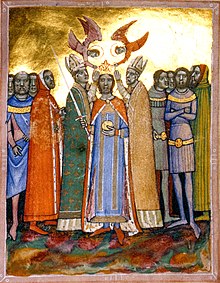
Géza I died on 25 April 1077.
If someone, freeman or bondman, should be caught in theft, he shall be hanged. But if he flees to the church to evade the gallows, he shall be led out of the church and blinded. A bondman caught in theft, if he does not flee to the church, shall be hanged; the owner of the stolen goods shall take a loss in the lost goods. The sons and daughters of a freeman caught in theft who fled to the church, was led out and blinded, if they are ten years old or less, shall retain their freedom; but if they are older than ten years they shall be reduced to servitude and lose all their property. A bondman or freeman who steals a goose or a hen shall lose one eye and shall restore what he has stolen.
— Laws of King Ladislas I[46]

The Illuminated Chronicle claims that Ladislaus planned to "restore the kingdom" to Solomon and "himself have the dukedom",[41][42][40] but almost all contemporaneous sources contradict this report.[47] Ladislaus approached Pope Gregory VII, who was the primary opponent of Solomon's ally, Henry IV of Germany.[47] At the Pope's request, Ladislaus sheltered Bavarian nobles who had rebelled against Henry.[48][49] In 1078 or 1079, Ladislaus married Adelaide, a daughter of Rudolf of Rheinfelden, whom the German princes had elected to take the place of Henry IV as king.[48][49][50] Ladislaus supported Leopold II, Margrave of Austria, who also rebelled against Henry IV; however, the German monarch forced Leopold to surrender in May 1078.[51]
Taking advantage of the internal conflicts in the Holy Roman Empire, Ladislaus besieged and captured the fortress of Moson from Solomon in early 1079.[50][52] However, Henry IV stormed the western regions of Hungary, and secured Solomon's position.[52] The German invasion also prevented Ladislaus from assisting Boleslaus the Bold, who fled to Hungary after his subjects expelled him from Poland.[53] Ladislaus initiated negotiations with Solomon, who abdicated in 1080 or 1081 in exchange for "revenues sufficient to bear the expenses of a king".[45][50][52][54] However, Solomon soon began conspiring against Ladislaus, and Ladislaus imprisoned him.[42][52]
The first five Hungarian saints, including the first king of Hungary,
[The] Lord, in order to show how merciful [King Stephen I] had been while living in a mortal body, demonstrated his approval of [Stephen's revelation as a saint] before all other works when [the king] was already reigning with Christ to the point that though for three days they struggled with all their might to raise his holy body, it was not by any means to be moved from its place. For in that time, because of the sins, a grave discord arose between the said king Ladislas and his cousin Solomon, because of which, Solomon, captured, was held in prison. Therefore when they tried in vain to raise the body, a certain recluse at the church of the Holy Savior in Bökénysomlyó, by the name of Karitas, whose famous life at the time was held in esteem, confided to the king by a revelation made to her from heaven that they exerted themselves in vain; it would be impossible to transfer the relics of the holy king until unconditional pardon was offered to Solomon, setting him free from the confinement of prison. And thus, bringing him forth from the prison, and repeating the three-day fast, when the third day arrived for the transferal of the holy remains, the stone lying over the grave was lifted up with such ease as if it had been of no weight before.
After his release, Solomon made a final effort to regain his crown.
Expansion (1085–1092)
In August 1087, German princes who opposed Henry IV's rule held a conference in
King
Ladislaus admitted in his letter to Oderizius that he could not "promote the cause of earthly dignities without committing grave sins".[72] Historian Bálint Hóman says that Ladislaus was referring to a developing conflict with Pope Urban II, who objected to Ladislaus's refusal to acknowledge the Holy See's suzerainty over Croatia.[72][73][74][75] In the letter, Ladislaus styled himself as "king of the Hungarians and of Messia".[63][76][77] Historian Ferenc Makk writes that the latter title referred to Moesia, implying that Ladislaus had taken the regions between the Great Morava and Drina rivers from the Byzantine Empire.[63] No other documents refer to Ladislaus's occupation of Moesia, suggesting that if Ladislaus did occupy the region, he lost it quickly.[76] Alexandru Madgearu says that "Messia" should rather be associated with Bosnia, which was occupied during Ladislaus's campaign against Croatia.[77]
The
Bernold of St Blasien writes that Duke
Last years (1092–1095)

Ladislaus intervened in a conflict between
The Illuminated Chronicle states that "messengers from
Ladislaus died near the Hungarian-Bohemian border on 29 July 1095.
Family
| Ancestors of Ladislaus I of Hungary Dobrawa of Bohemia | ||||||||||||||||
|---|---|---|---|---|---|---|---|---|---|---|---|---|---|---|---|---|
| 6. Mieszko II Lambert of Poland | ||||||||||||||||
| 26. Dobromir | ||||||||||||||||
| 13. Emnilda | ||||||||||||||||
| 3. Richeza or Adelaide of Poland | ||||||||||||||||
| 14. Ezzo, Count Palatine of Lotharingia | ||||||||||||||||
| 7. Richeza of Lotharingia | ||||||||||||||||
| 30. Otto II, Holy Roman Emperor | ||||||||||||||||
| 15. Matilda of Germany | ||||||||||||||||
| 31. Theophanu | ||||||||||||||||
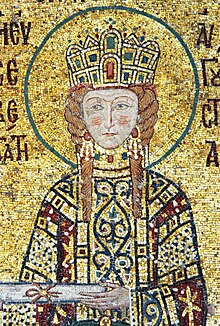
Historian Gyula Kristó says that Ladislaus had a first wife,
Ladislaus's family and relatives who are mentioned in the article are shown in the following family tree.[107]
| a lady of the Tátony clan | Vazul | ||||||||||||||||||||||||||||||||||||||||||||||||||||
| Andrew I | Béla I | Richeza or Adelaide | |||||||||||||||||||||||||||||||||||||||||||||||||||
Solomon | |||||||||||||||||||||||||||||||||||||||||||||||||||||
Zvonimir of Croatia | |||||||||||||||||||||||||||||||||||||||||||||||||||||
Kings of Hungary (from 1095) | Iaroslav of Volhinia | daughter | Irene (born Piroska) | John II Komnenos | |||||||||||||||||||||||||||||||||||||||||||||||||
*According to a scholarly theory suggesting that Ladislaus had two wives.
Legacy

Consolidation of the Christian monarchy
For centuries, hagiographers and historians have emphasized Ladislaus's prominent role in the consolidation of the Christian monarchy.[108] The chronicles also stressed his idoneitas, or personal suitability, to reign, because the legitimacy of his rule was questionable.[108] The Illuminated Chronicle clearly states that Ladislaus knew that "the right of law between him and [Solomon] was not on his side but only the force of fact".[54][108]
After Ladislaus's victories over the Pechenegs and the Cumans, the nomadic peoples of the Pontic steppes stopped invading Hungary until the Mongol invasion of 1241.[109] Kristó suggests that the Székely people—a community of Hungarian-speaking warriors—started settling the easternmost borderlands under Ladislaus.[59][110] The "historic association of the Kingdom of Hungary and Croatia", which ended in 1918, began with Ladislaus's conquest of Croatia.[55] His conquest marked the beginning of a period of Hungarian expansion, which ensured that Hungary developed into a leading Central European power during the following centuries.[109] It became a customary rite for a newly crowned Hungarian king to make a pilgrimage to Ladislaus's shrine at Várad.[37] Louis I of Hungary, who made many attempts to expand his territory in the Balkan Peninsula, showed a special respect for Ladislaus.[111]
Hungary had never had as great as king, so they repute
And the land thereafter never bore that much and splendid fruit.
Veneration
St. Ladislaus | |
|---|---|
| Patronage | Patron Saint of Hungary Patron Saint of the Székelys Protector against pestilence |
Gábor Klaniczay emphasizes that Ladislaus "seemed expressly designed to personify the knight-king ideal" of his age.
The most popular story describes Ladislaus's fight with a "
[The] most blessed Duke Ladislaus saw one of the pagans who was carrying off on his horse a beautiful Hungarian girl. The saintly Duke Ladislaus thought that it was the daughter of the
The Hungarian Illuminated Chronicle[119]
During the reign of Stephen II of Hungary, Ladislaus's shrine in the cathedral of Várad became a preferred venue for trials by ordeal.[120] However, it cannot be determined whether Ladislaus became subject to veneration soon after his death, or if his cult emerged after he was canonized by Béla III of Hungary on 27 June 1192.[121] Béla had lived in the Byzantine court, where Ladislaus's daughter, Irene, was venerated as a saint.[122]
According to Thomas the Archdeacon,

Ladislaus's official legend, which was compiled after 1204,
Ladislaus is a patron saint of Hungary, especially along the borders.[127][128] In particular, soldiers and the Székely people venerate him.[120] A late medieval legend says that Ladislaus appeared at the head of a Székely army fighting against and routing a plundering band of Tatars in 1345.[120] He is also called upon during times of pestilence.[127] He is often depicted as a mature, bearded man wearing a royal crown and holding a long sword or banner.[127] He is also shown on his knees before a deer, or in the company of two angels.[127]
King Sigismund of Hungary died on 1437, and as ordered in life, he was buried at Várad (now Oradea), next to the tomb of the King Saint Ladislaus, who was the ideal of the perfect monarch, warrior and Christian for that time and was deeply venerated by Sigismund.[129]
Herma of King Saint Ladislaus and Genetics
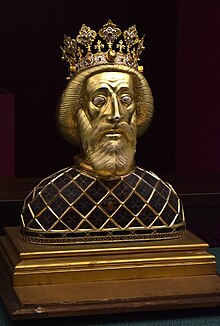
The skull relic in the Saint Ladislaus’ Herma preserved in the Cathedral Basilica of Győr, is one of the most important relics for Hungarians.[130]
King Saint Ladislaus of Hungary completed the work of King Saint Stephen of Hungary, he consolidated the Hungarian state power and strengthened the Christianity. His charismatic personality, strategic leadership and military talents resulted the termination of internal power struggles and foreign military threats. He was seen as the embodiment of the knight-king ideal to be emulated all over Europe. He was canonized in 1192 at the request of King Béla III of Hungary, and his body was exhumed to prepare relics from his skull and other skeletal remains as was the custom in that medieval times.[130]
According to historian György Szabados, Gyula László proved already in 1965 that the face of the Saint Ladislaus’ Herma depicts King Béla III. The skull reconstruction of the Royal Basilica's tomb find in Székesfehérvár also shows the face of the Herma, which is not surprising, because King Ladislaus had already been dead for 97 years in 1192, so only the then living king from the same family, Béla III was worthy to sit as a model for the creation of the face of the Herma.[131]
The wooden herm containing the skull was damaged in a fire in 1406, but miraculously the skull has been preserved unharmed. Later it was placed into the current Herma created during the reign of King Sigismund of Hungary. In the 16th century, the relic had to be rescued from Várad due to the ravage of Transylvania by the protestants. In the first decades of the 17th century, it reached its current location in the Cathedral of Győr after passing through Prague, Pozsony (now Bratislava) and Veszprém.[130]
The turbulent history events of the Herma raised doubts concerning the authenticity of the relic by historians and archaeologists.[130] At that time, the only Árpád dynasty king, the remains of King Béla III had known and identified, because little earlier, the Institute of Hungarian Research determinated the whole genome data of King Béla III which was published in 2020.[132] Thus the Hungarian scholars were able to compare the paternal Y chromosome sequence of the skull to that of King Béla III from whom a whole genome data was available.[130]
On 4 June 2021, Endre Neparáczki collected a sample from the skull of the herm, during his researches so far, they isolated from the sample one of the best own extracted endogenous DNA.[133] The Institute of Hungarian Research defined the genetic composition of the skull found in the herm and it was published in 2023. The result supported the originality of Saint Ladislaus relic, the Y chromosome of the skull belongs to the exclusive haplogroup of the Árpád-dynasty R-ARP (R1a1a1b2a2a1c3a3b) and the kinship analysis detected the skull is at five generations distance from King Béla III.[130][133]
The R-ARP sub-haplogroup belongs to the R-Z2123 clade, the phylogenetic analysis suggested a Bronze Age BMAC origin of the R-Z2123 sub-haplogroup which belongs to the R-Z2125 clade, which was detected in individuals from the Middle-Late Bronze Age on the Caspian Steppe, connected to the Potapovka, Sintashta and Andronovo cultures. In the Iron Age, this haplogroup was detected in the Turan basin and in Scytho-Siberians of the Minusinsk Basin, later among the Asian Huns (Xiongnus) and up until the Middle Ages in Mongolia which indicates an eastward and southward spread of the haplogroup. The first appearance of R-Z2125 in the Carpathian Basin was detected in 5th-century European Huns, and 7th–8th-century Avars, but it also arrived with the conquering Hungarians, in the 9th–10th century including Árpád and his family.[130] The basic premise of the Hungarian medieval chronicle tradition (for example in the Chronicon Pictum) that the Huns, i.e. the Hungarians coming out twice from Scythia, the guiding principle was the Hun-Hungarian continuity.[134] The genomic analyses of the Hungarian royal Árpád family members are in line with the reported conquering Hungarian-Hun origin of the dynasty in harmony with their Y-chromosomal phylogenetic connections.[130]
The Institute of Hungarian Research published a genetic study in 2022 in which 113 Hungarian conqueror samples were analized.[135] The result of the genome analysis of King Saint Ladislaus confirmed that the Árpád dynasty originated from the same ethnic group as other members of the Hungarian conqueror elite, and he had higher genetic affinity to the Hungarian conquerors than the analyzed later Hungarian royal members. King Saint Ladislaus had more Eastern genomic heritage than his later relatives, on the PCA genetic map he shifted slightly eastward from the cloud of modern European populations, while the genome of King Béla III was projected near modern Hungarians and Croatians, because the Central Asian genomes were progressively attenuated during the centuries through dynastic marriages with European royal families.[130][133]
Saint Ladislaus became the first saint in the world whose identity was confirmed by archaeogenetic tests.[133]
Gallery
-
Saint Ladislaus (painting by Simone Martini, 1326) (Museo Civico di Santa Maria della Consolazione, Altomonte, Italy)
-
1. Burial of Saint Ladislaus. 2. Persons praying at his tomb. 3. A rich man unable to lift a silver tray from his tomb. 4. A poor man lifting the silver tray. (Anjou Legendarium, 14th century)
-
In the initial "P", Prince Ladislaus is fighting a duel with a Cuman warrior (Chronicon Pictum, 1358)
-
Saint Ladislaus chases the Cuman warrior who kidnapped a girl (Chronica Hungarorum, 1488)
-
Saint Ladislaus the knight-king (Chronica Hungarorum, 1488)
-
King Saint Ladislaus (Nádasdy Mausoleum, 1664)
-
Saint Ladislaus at Battle of Cserhalom (painting by Károly Kisfaludy, 1826–1830) (Hungarian National Gallery, Budapest)
-
The depiction of the Battle of Cserhalom in the Saint Ladislaus chapel, Matthias Church (Budapest, Hungary) (painting by Károly Lotz, 19th century). King Saint Ladislaus of Hungary saves the kidnapped Hungarian girl from a Cuman warrior.
-
Saint Ladislaus in the Saint Stephen room in the Buda Castle
-
Statue of Saint Ladislaus at the Heroes' Square, Budapest
-
Statue of Saint Ladislaus made to memory of the Battle of Mogyoród in Mogyoród, Hungary (made by Lajos Józsa in 2001)
-
Statue of Saint Ladislaus in Szekszárd, Hungary (made by Benedek Nagy in 2001). The composition was based on the Ladislaus and Cuman warrior duel scene in the initial "P" in the Chronicon Pictum.
-
Horse statue of Saint Ladislaus in the Roman Catholic Diocese of Oradea, Romania (made by Árpád Deák in 2023)
See also
References
- ^ Klaniczay 2002, p. 187.
- ^ a b c d Makk 1994, p. 394.
- ^ Kristó & Makk 1996, pp. 78, 107.
- ^ a b c d e f g h Kristó & Makk 1996, p. 107.
- ^ a b c Bárány 2012, p. 338.
- ^ Klaniczay 2002, p. 174.
- ^ a b The Deeds of the Princes of the Poles (ch. 27.), p. 97.
- ^ a b Kontler 1999, p. 60.
- ^ Engel 2001, p. 30.
- ^ Kristó & Makk 1996, p. 79.
- ^ The Hungarian Illuminated Chronicle (ch. 65.92), p. 115.
- ^ a b Érszegi & Solymosi 1981, p. 88.
- ^ a b Engel 2001, p. 31.
- ^ Kontler 1999, p. 61.
- ^ Robinson 1999, p. 53.
- ^ Érszegi & Solymosi 1981, pp. 88–89.
- ^ a b Bartl et al. 2002, pp. 26–27.
- ^ a b Érszegi & Solymosi 1981, p. 89.
- ^ a b c Bartl et al. 2002, p. 27.
- ^ Steinhübel 2011, p. 27.
- ^ a b Kristó & Makk 1996, p. 106.
- ^ a b Klaniczay 2002, pp. 176–177.
- ^ Kristó & Makk 1996, pp. 107–108.
- ^ a b c d Kristó & Makk 1996, p. 109.
- ^ The Hungarian Illuminated Chronicle (ch. 79.111), p. 119.
- ^ a b c Kosztolnyik 1981, p. 85.
- ^ a b c d e Kristó & Makk 1996, p. 110.
- ^ a b c d e Steinhübel 2011, p. 28.
- ^ a b c Érszegi & Solymosi 1981, p. 90.
- ^ a b Klaniczay 2002, p. 177.
- ^ The Hungarian Illuminated Chronicle (ch. 83.120), p. 123.
- ^ The Hungarian Illuminated Chronicle (ch. 85.121), p. 124.
- ^ The Hungarian Illuminated Chronicle (ch. 84.121), p. 124.
- ^ a b Kristó & Makk 1996, p. 94.
- ^ Klaniczay 2002, pp. 177–178.
- ^ The Hungarian Illuminated Chronicle (ch. 87–88.124), p. 125.
- ^ a b Engel 2001, p. 32.
- ^ The Deeds of the Princes of the Poles (ch. 27–28.), pp. 97–99.
- ^ Manteuffel 1982, p. 97.
- ^ a b Kristó & Makk 1996, p. 114.
- ^ a b The Hungarian Illuminated Chronicle (ch. 93.131), p. 127.
- ^ a b c Kosztolnyik 1981, p. 93.
- ^ Laws of King Ladislas I (Ladislas II:Preamble), p. 12.
- ^ a b c Kontler 1999, p. 62.
- ^ a b c d e f Engel 2001, p. 33.
- ^ Laws of King Ladislas I (Ladislas II:12), pp. 14–16.
- ^ a b Kristó & Makk 1996, pp. 117–118.
- ^ a b c Kosztolnyik 1981, p. 94.
- ^ a b c d e f g Kristó & Makk 1996, p. 118.
- ^ a b c Érszegi & Solymosi 1981, p. 92.
- ^ Robinson 1999, p. 191.
- ^ a b c d e Kristó & Makk 1996, p. 119.
- ^ Manteuffel 1982, p. 98.
- ^ a b The Hungarian Illuminated Chronicle (ch. 94.133), p. 128.
- ^ a b Kontler 1999, p. 63.
- ^ Kontler 1999, p. 64.
- ^ Hartvic, Life of King Stephen of Hungary (ch. 24.), p. 393.
- ^ a b c d Érszegi & Solymosi 1981, p. 93.
- ^ a b Kristó & Makk 1996, p. 121.
- ^ Robinson 1999, p. 263.
- ^ Bernold of St Blasien, Chronicle (year 1087), p. 290.
- ^ a b Kosztolnyik 1981, p. 100.
- ^ a b c d Kristó & Makk 1996, p. 120.
- ^ a b Fine 1991, p. 283.
- ^ a b c d e Curta 2006, p. 265.
- ^ a b Magaš 2007, p. 48.
- ^ Fine 1991, pp. 282, 284.
- ^ Archdeacon Thomas of Split: History of the Bishops of Salona and Split (ch. 17.), p. 93.
- ^ Bárány 2012, p. 345.
- ^ Magaš 2007, pp. 48–49.
- ^ a b c Fine 1991, p. 284.
- ^ a b c Kosztolnyik 1981, p. 101.
- ^ Curta 2006, p. 266.
- ^ Kristó & Makk 1996, pp. 121–122.
- ^ Engel 2001, p. 34.
- ^ a b Makk & Thoroczkay 2006, p. 143.
- ^ a b Madgearu 2013, p. 98.
- ^ Bánlaky, József. "László második hadjárata a kúnok ellen 1091-ben" [The Second Campaign of Ladislaus Against the Cumans in 1091]. A magyar nemzet hadtörténelme [The Military History of the Hungarian Nation] (in Hungarian). Budapest.
- ^ a b Bárány 2012, p. 340.
- ^ a b The Hungarian Illuminated Chronicle (ch. 98.138), p. 129.
- ^ a b c d e f g Kristó & Makk 1996, p. 122.
- ^ Bárány 2012, p. 339.
- ^ Kosztolnyik 1981, p. 102.
- ^ Kosztolnyik 1981, p. 103.
- ^ Bernold of St Blasien, Chronicle (year 1092), p. 307.
- ^ The letters of Henry IV: Henry thanks Duke Almus for his support and promises him a reward, p. 171.
- ^ Makk & Thoroczkay 2006, p. 163.
- ^ Kristó & Makk 1996, pp. 122, 133.
- ^ Kristó & Makk 1996, p. 116.
- ^ Kosztolnyik 1981, p. 105.
- ^ Kosztolnyik 1981, p. 108.
- ^ Kristó & Makk 1996, p. 117.
- ^ Engel 2001, p. 43.
- ^ a b Manteuffel 1982, p. 101.
- ^ Manteuffel 1982, pp. 101–102.
- ^ Kosztolnyik 1981, p. 104.
- ^ The Hungarian Illuminated Chronicle (ch. 100.139), p. 130.
- ^ a b c d Klaniczay 2002, p. 186.
- ^ Klaniczay 2002, p. 418.
- ^ a b Font 2001, p. 15.
- ^ The Hungarian Illuminated Chronicle (ch. 101.139), p. 130.
- ^ a b Klaniczay 2002, p. 175.
- ^ Kristó & Makk 1996, p. 107, Appendices 1–2.
- ^ Wiszewski 2010, pp. 29–30, 60, 376.
- ^ Ferdinandy 2000, p. 208, Appendix.
- ^ Kristó & Makk 1996, p. Appendix 2.
- ^ Kristó & Makk 1996, pp. Appendices 1–2.
- ^ a b c d e Klaniczay 2002, p. 173.
- ^ a b Engel 2001, p. 37.
- ^ Engel 2001, p. 115.
- ^ Cartledge 2011, p. 36.
- ^ Hartvic, Life of King Stephen of Hungary (ch. 24.), p. 394.
- ^ Klaniczay 2002, pp. 177, 190.
- ^ a b c László 1996, p. 142.
- ^ Bárány 2012, pp. 339–340.
- ^ a b László 1996, p. 143.
- ^ Klaniczay 2002, pp. 190–191.
- ^ Klaniczay 2002, pp. 192–193.
- ^ The Hungarian Illuminated Chronicle (ch. 73–74.103), p. 119.
- ^ a b c Kristó & Makk 1996, p. 123.
- ^ Klaniczay 2002, pp. 174, 182.
- ^ Klaniczay 2002, p. 182.
- ^ Klaniczay 2002, p. 185.
- ^ Archdeacon Thomas of Split: History of the Bishops of Salona and Split (ch. 23.), p. 133.
- ^ Klaniczay 2002, pp. 185–186.
- ^ "Egyházmegyénk: Történet – A Szent László herma [Our Diocese: History – St Ladislaus's reliquary]". Győri Egyházmegye [Diocese of Győr]. gyor.egyhazmegye.hu. 2008. Archived from the original on 17 February 2015. Retrieved 17 February 2015.
- ^ a b c d e f g Lanzi & Lanzi 2004, p. 142.
- ^ László 1996, p. 145.
- ^ Bertényi Iván. (2000). A Tizennegyedik Század története. Budapest: Pannonica kiadó.
- ^ PMID 35809778.
- ^ György, Sabados (26 June 2020). "Korai magyar múlt az átdolgozott történelem tankönyvekben - interjú Szabados György történésszel, tananyagfejlesztővel" [Early Hungarian past in revised history textbooks - interview with historian György Szabados, curriculum developer]. Történelemoktatók Szakmai Egyesülete (Professional Association of History Teachers) (in Hungarian).
- PMID 32636469.
- ^ a b c d Endre, Neparáczki (22 August 2022). "Saint László is more Asian than most of our kings". Magyarságkutató Intézet (Institute of Hungarian Research).
- ISSN 0021-1486.
- S2CID 246191357.
Sources
Primary sources
- "Bernold of St Blasien, Chronicle" (2008). In Robinson, I. S. Eleventh-Century Germany: The Swabian Chronicles. Manchester University Press. pp. 245–337. ISBN 978-0-7190-7734-0.
- "Hartvic, Life of King Stephen of Hungary" (Translated by Nora Berend) (2001). In Head, Thomas. Medieval Hagiography: An Anthology. Routledge. pp. 378–398. ISBN 0-415-93753-1.
- "The letters of Henry IV: Henry thanks Duke Almus for his support and promises him a reward" (2000). In Imperial Lives & Letters of the Eleventh Century (Translated by Theodor E. Mommsen and Karl F. Morrison, with a historical introduction and new suggested readings by Karl F. Morrison, edited by Robert L. Benson). Columbia University Press. pp. 52–100. ISBN 978-0-231-12121-7.
- The Deeds of the Princes of the Poles (Translated and annotated by Paul W. Knoll and Frank Schaer with a preface by Thomas N. Bisson) (2003). CEU Press. ISBN 963-9241-40-7.
- The Hungarian Illuminated Chronicle: Chronica de Gestis Hungarorum (Edited by Dezső Dercsényi) (1970). Corvina, Taplinger Publishing. ISBN 0-8008-4015-1.
- "The Laws of King Ladislas I (1077–1095)". In The Laws of the Medieval Kingdom of Hungary, 1000–1301 (Translated and Edited by János M. Bak, György Bónis, James Ross Sweeney with an essay on previous editions by Andor Czizmadia, Second revised edition, In collaboration with Leslie S. Domonkos) (1999). Charles Schlacks, Jr. Publishers. pp. 11–22. OL 12153527M. (ISBN may be misprinted in the book as 88445-29-2).
- Archdeacon Thomas of Split: History of the Bishops of Salona and Split (Latin text by Olga Perić, edited, translated and annotated by Damir Karbić, Mirjana Matijević Sokol and James Ross Sweeney) (2006). CEU Press. ISBN 963-7326-59-6.
Secondary sources
- Bárány, Attila (2012). "The Expansion of the Kingdom of Hungary in the Middle Ages (1000–1490)". In Berend, Nóra (ed.). The Expansion of Central Europe in the Middle Ages. Ashgate Variorum. pp. 333–380. ISBN 978-1-4094-2245-7.
- Bartl, Július; Čičaj, Viliam; Kohútova, Mária; Letz, Róbert; Segeš, Vladimír; Škvarna, Dušan (2002). Slovak History: Chronology & Lexicon. Bolchazy-Carducci Publishers, Slovenské Pedegogické Nakladatel'stvo. ISBN 0-86516-444-4.
- Cartledge, Bryan (2011). The Will to Survive: A History of Hungary. C. Hurst & Co. ISBN 978-1-84904-112-6.
- Curta, Florin (2006). Southeastern Europe in the Middle Ages, 500–1250. Cambridge University Press. ISBN 978-0-521-89452-4.
- Engel, Pál (2001). The Realm of St Stephen: A History of Medieval Hungary, 895–1526. I.B. Tauris Publishers. ISBN 1-86064-061-3.
- Érszegi, Géza; Solymosi, László (1981). "Az Árpádok királysága, 1000–1301 [The Monarchy of the Árpáds, 1000–1301]". In Solymosi, László (ed.). Magyarország történeti kronológiája, I: a kezdetektől 1526-ig [Historical Chronology of Hungary, Volume I: From the Beginning to 1526] (in Hungarian). Akadémiai Kiadó. pp. 79–187. ISBN 963-05-2661-1.
- Ferdinandy, Mihály (2000). III. Ottó, a szent császár [Otto III, the Holy Emperor] (in Hungarian). Balassi Kiadó. ISBN 963-506-336-9.
- ISBN 0-472-08149-7.
- Font, Márta (2001). Koloman the Learned, King of Hungary (Supervised by Gyula Kristó, Translated by Monika Miklán). Márta Font (supported by the Publication Commission of the Faculty of Humanities of the University of Pécs). ISBN 963-482-521-4.
- Klaniczay, Gábor (2002). Holy Rulers and Blessed Princes: Dynastic Cults in Medieval Central Europe. Cambridge University Press. ISBN 0-521-42018-0.
- Kontler, László (1999). Millennium in Central Europe: A History of Hungary. Atlantisz Publishing House. ISBN 963-9165-37-9.
- Kosztolnyik, Z. J. (1981). Five Eleventh Century Hungarian Kings: Their Policies and their Relations with Rome. Boulder. ISBN 0-914710-73-7.
- Kristó, Gyula; Makk, Ferenc (1996). Az Árpád-ház uralkodói [Rulers of the House of Árpád] (in Hungarian). I.P.C. Könyvek. ISBN 963-7930-97-3.
- Lanzi, Fernando; Lanzi, Gioia (2004). Saints and Their Symbols: Recognizing Saints in Art and in Popular Images. Order of Saint Benedict. ISBN 0-8146-2970-9.
- László, Gyula (1996). The Magyars: Their Life and Civilisation. Corvina. ISBN 963-13-4226-3.
- Madgearu, Alexandru (2013). Byzantine Military Organization on the Danube, 10th–12th Centuries. Brill. ISBN 978-90-04-21243-5.
- Magaš, Branka (2007). Croatia Through History. SAQI. ISBN 978-0-86356-775-9.
- Makk, Ferenc (1994). "I. (Szt.) László". In Kristó, Gyula; Engel, Pál; Makk, Ferenc (eds.). Korai magyar történeti lexikon (9–14. század) [Encyclopedia of the Early Hungarian History (9th–14th centuries)] (in Hungarian). Akadémiai Kiadó. pp. 394–396. ISBN 963-05-6722-9.
- Makk, Ferenc; Thoroczkay, Gábor (2006). Írott források az 1050–1116 közötti magyar történelemről [Written Sources of the Hungarian History between 1050 and 1116] (in Hungarian). Szegedi Középkorász Műhely. ISBN 978-963-482-794-8.
- Manteuffel, Tadeusz (1982). The Formation of the Polish State: The Period of Ducal Rule, 963–1194 (Translated and with an Introduction by Andrew Gorski). Wayne State University Press. ISBN 0-8143-1682-4.
- Robinson, I. S. (1999). Henry IV of Germany, 1056–1106. Cambridge University Press. ISBN 0-521-54590-0.
- Steinhübel, Ján (2011). "The Duchy of Nitra". In Teich, Mikuláš; Kováč, Dušan; Brown, Martin D. (eds.). Slovakia in History. Cambridge University Press. pp. 15–29. ISBN 978-0-521-80253-6.
- Wiszewski, Przemysław (2010). Domus Bolezlai: Values and Social Identity in Dynastic Traditions of Medieval Poland (c. 966–1138). Brill. ISBN 978-90-04-18142-7.
Further reading
- Bain, Robert Nisbet (1911). . In Chisholm, Hugh (ed.). Encyclopædia Britannica. Vol. 16 (11th ed.). Cambridge University Press. p. 59.
- Berend, Nora; Urbańczyk, Przemysław; Wiszewski, Przemysław (2013). Central Europe in the High Middle Ages: Bohemia, Hungary and Poland, c. 900–c. 1300. Cambridge University Press. ISBN 978-0-521-78156-5.
- Szakács, Béla Zsolt (2006). "Between Chronicle and Legend: Image Cycles of St Ladislas in Fourteenth-Century Hungarian Manuscripts". In Kooper, Erik (ed.). The Medieval Chronicle IV. Rodopi B.V. pp. 149–176. ISBN 978-90-420-2088-7.
External links
![]() Media related to Ladislaus I of Hungary at Wikimedia Commons
Media related to Ladislaus I of Hungary at Wikimedia Commons

